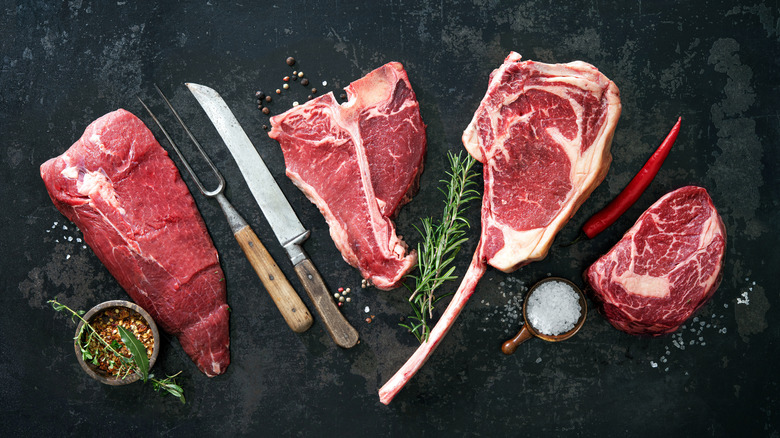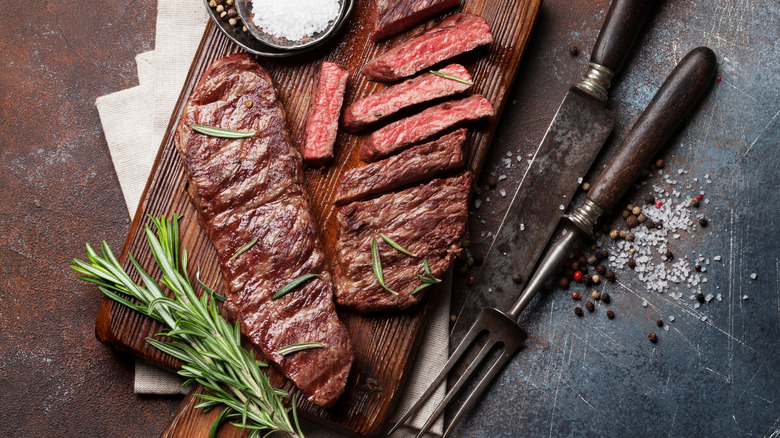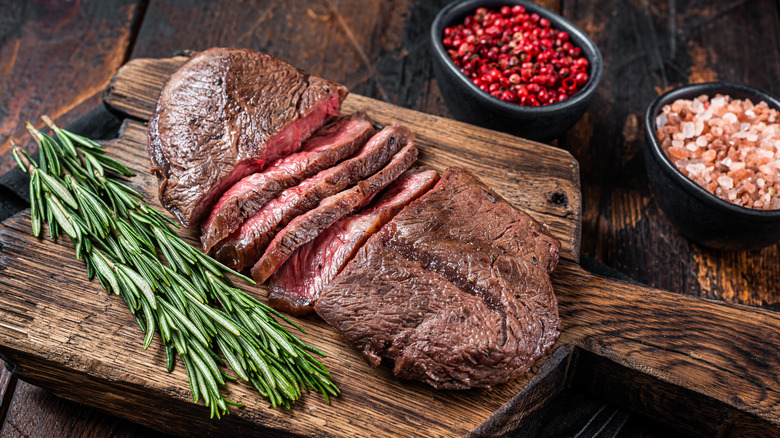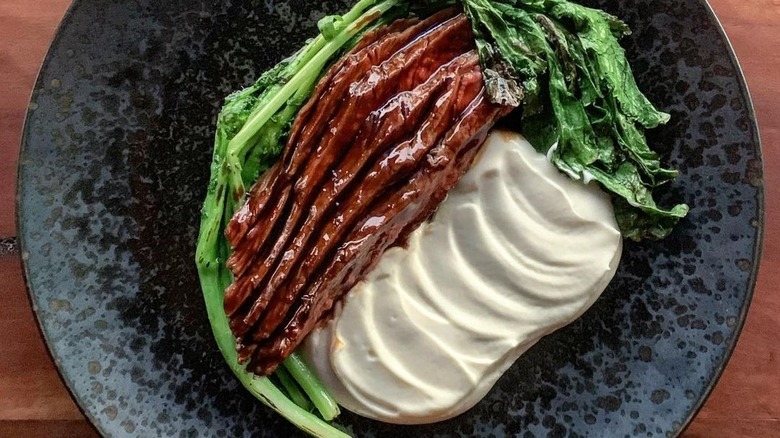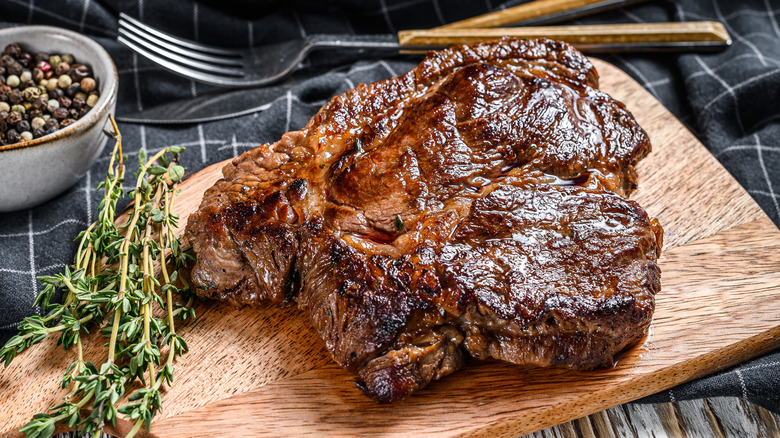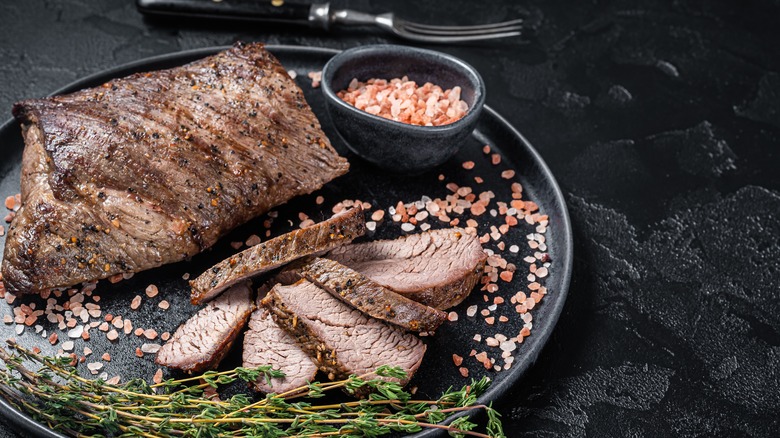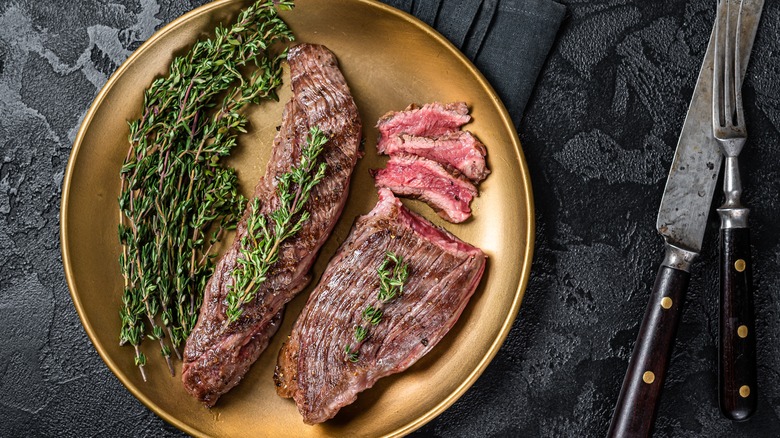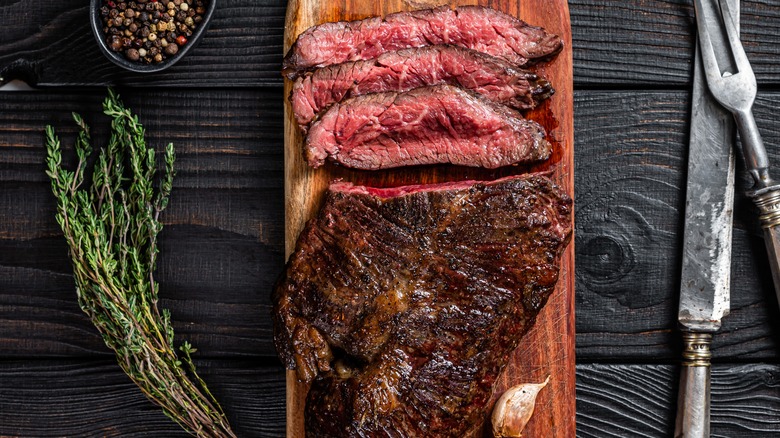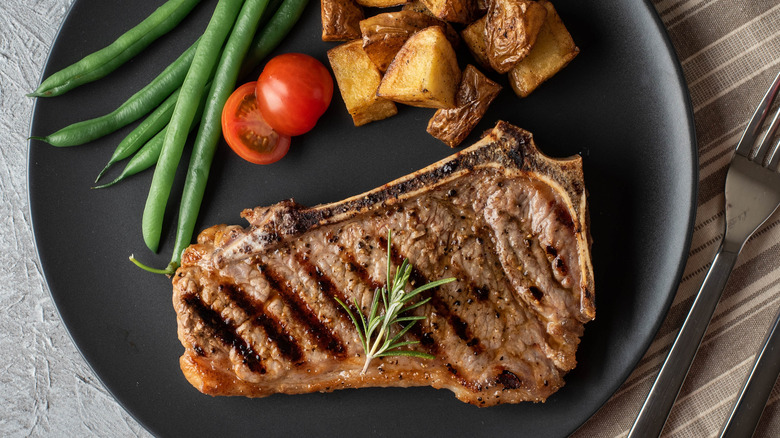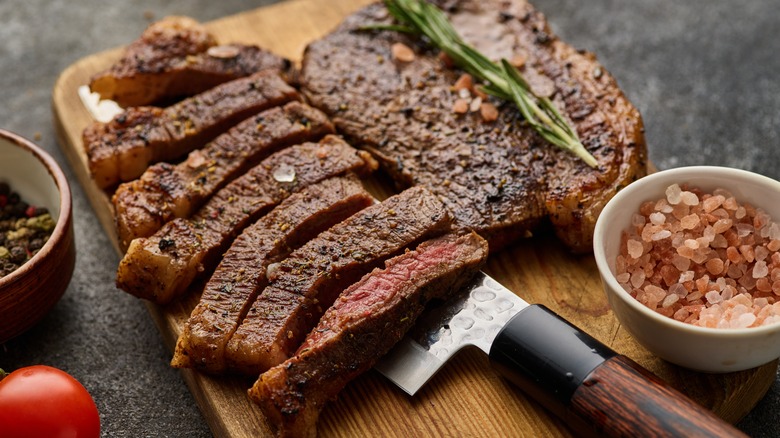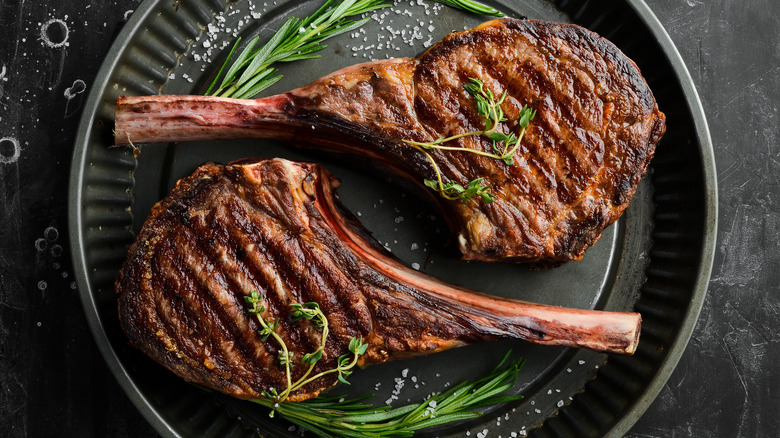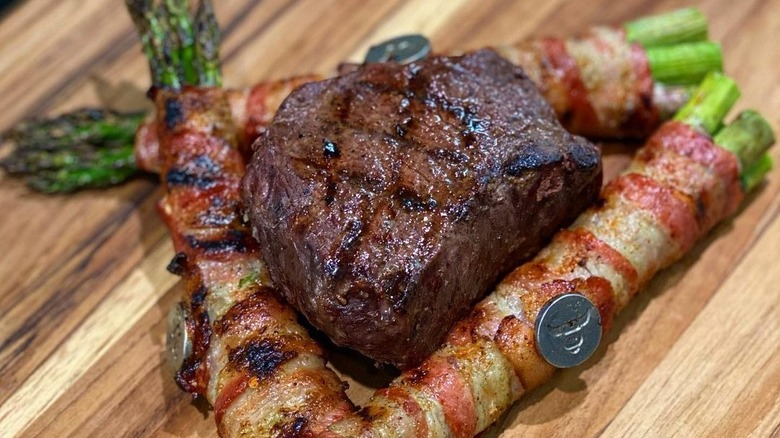11 Not-So-Popular Steaks You Should Always Order If You See Them At A Steakhouse
Americans love beef! On average, we eat more than 50 pounds of beef annually, or more than 30 billion pounds of beef collectively as a country each year. We eat it in burgers, decadent pasta dishes, and spicy Mexican meals. If we're lucky, we also eat a ton of that beef in local steakhouses where T-bones, ribeyes, and porterhouses reign supreme. After all, what's better than a thick, juicy, tender steak, beautifully charred and crusted over an open flame or seared to perfection in a cast iron skillet? Not much!
So with all that incredible beef available — and all the different ways to enjoy it — it only makes sense to mix things up from time to time. Believe it or not, as much beef as you've probably eaten in your life, there are still many varieties of steak out there that you might have missed.
Some are rare. Others are newer cuts that are just gaining popularity and exposure. Whatever the case, these are steaks you need to try and experience. So if you see one of these on the menu next time you're visiting your favorite steakhouse, be sure to order it. Dig in, savor the meat, and enjoy the experience. Who knows? You might just find your new favorite cut.
Denver steak
When it comes to lesser-known steaks you need to try, the Denver steak should be at the top of any list. Sourced from the chuck area of the cow, the Denver steak is an especially flavorful and tender cut of beef, with a hearty taste and a texture similar to sirloin. It's also a steak that is typically highly marbled with fat, which increases the flavor and tenderness of the cut. Because of their high quality, these mid-size steaks are typically grilled, broiled, or fried in a cast iron skillet. For the best-tasting steak, order yours cooked to medium-rare or medium at most. More heat and the meat risks becoming tough.
Most Denver steaks are marinated in a sauce or red wine before they are cooked. Dry rubs are another common preparation. As such, the meat pairs incredibly well with several traditional steakhouse sides, including roasted vegetables, mashed potatoes, rice pilaf, or a fresh green salad.
And as for its name, don't let that Mile High connection fool you. The Denver steak isn't an old-school cut that's been passed down by ranchers generation after generation. The origins are murky at best, but most believe the name was dreamed up by a group of marketers in the early 2000s. The new branding might have been a wise choice, as its previous names — "chuck under blade" or "boneless chuck steak" — didn't really roll off the tongue!
Flat iron steak
Born from the same marketing blitz that brought us the Denver steak, the flat iron steak is another relatively new cut of beef that has gained a growing number of fans over the last 20 years. Although Denver steaks and flat iron steaks both come from the same region on the cow, flat iron steaks tend to be smaller — around 8 to 10 ounces on average, or the perfect size for any weeknight meal. Or whenever that 32-ounce monster steak is just a little too daunting!
As for taste, the flat iron has the rich, umami flavor you'd expect from any great piece of beef. There is generally a fair amount of marbling on each of the steaks as well, so they're always tender and flavorful. However, the fat is not as excessive as you sometimes get on a ribeye or sirloin. Combined with its more compact size, this means less fat and fewer calories overall, making the flat iron one of the healthier steaks you can order.
Flat iron steaks are also one of the more versatile pieces of meat you can buy, so whether you're ordering them in a steakhouse or cooking them at home, the preparation options are plentiful. The steak is great grilled, broiled, pan-seared, or even cooked sous vide. Just be sure not to overcook it. This is another steak that shouldn't be ordered more than medium-rare to ensure maximum tenderness and flavor.
Merlot steak
The merlot steak gets its name from the incredible way it pairs with merlot wine. Both are smooth, rich, and full of flavor. An affordable, smaller-sized piece of meat, merlot steak comes from the rump and hind legs of the cow. This is an area where the muscles are used extensively, so the meat is incredibly lean and packed with minerals and flavor. Other cuts of beef from this so-called "round" area of the cow also include roasts and ground beef.
Although merlot steak runs the risk of being tough if it's not prepared well, that's nothing a good chef or home cook can't overcome with the right technique. The merlot steak tastes best when prepared quickly over high heat, making it perfect for the grill or charring in a cast iron skillet with a bit of oil. Flavorful citrus or soy marinades can help bring out the flavor of the merlot steak and ensure maximum tenderness. Braising is another great option to help make sure the merlot's meat gets that melt-in-your-mouth texture.
In addition to the aforementioned merlot, these steaks pair beautifully with bold, full-bodied red wines including cabernet Sauvignon. It's also the perfect accompaniment for traditional hearty steakhouse faves like roasted vegetables or mashed potatoes. You can also order yours with a large Caesar salad or save it for your next Sunday brunch. Merlot steaks go great with eggs!
Chuck eye steak
Once referred to derogatorily as "poor man's ribeye," the lower cost of chuck eye steak (plus its incredible similarity to the classic ribeye) is now one of its biggest selling points. The chuck eye steak is now regarded by many as the ideal cut of beef for meat lovers who want a flavorful meal without breaking the bank. The chuck eye steak (or the Delmonico as some call it) originates from what's known as the chuck primal portion of the cow, which is located around the shoulder area. This is the same region ribeye steaks come from, except the chuck eye steak is a tad closer to the shoulder, where the meat is a bit leaner and where marbling is less extensive, making it a less-expensive alternative to that pricier cut.
Like the rib eye, the chuck eye steak is famed for its robust, beefy flavor. It's still tender and juicy like most steaks but also has a slightly firmer texture which many enjoy. That added texture, plus the natural fat found in and around the steak, make it perfect for grilling, broiling, and pan-searing.
The slight bit of natural earthiness in a chuck eye also means it pairs especially well with other bold flavors, such as garlic, rosemary, and black pepper. Maximize your dining experience when eating at a favorite steak joint by ordering yours with classics like grilled Brussels sprouts or asparagus. Delish!
Tri-tip steak
Beloved by many across the U.S. and especially in the Golden State where it originated, the tri-tip steak (also known as California cut or Santa Maria steak) is a relatively lean and flavorful cut, loved for its tenderness and the many ways it can be prepared. Popularized in the 1950s, tri-tip steak originates from the bottom sirloin of the cow, located just above the flank and below the loin. It's a triangular-shaped steak and unique in that you can only get two per animal — one cut from each side.
The tri-tip is also special in that it isn't always the same thickness. The corners tend to be thinner while the center is thicker and juicier. That's perfect for people who like some variety with their steak. This also means that you can order it medium or medium-well and still get crispy caramelized ends ... the best of both worlds!
In a steakhouse setting, tri-tips tend to be grilled, although if you luck out, you may also be able to find them smoked. Smoking not only adds a delicious flavor to the meat, but it also allows the chef to create a beautifully charred crust that's delicious on its own. This also locks in the natural juices, ensuring the middle of the steak stays flavorful and succulent.
Bavette steak
A favorite in specialty meat shops and higher-end steakhouses, the bavette is a lesser-known steak here in the U.S. However, in France where it originated, the bavette is one of the most popular steaks for fine dining. Locals call it "bavette d'aloyau" which translates loosely as "bib steak" or "flap steak." That name stems from the portion of the cow where the steak is located — a long, thin flap alongside the underbelly of the animal, near where flank steaks are cut. The bavette was once known as butcher's steak, as it was so highly desired that butchers preferred to keep it for themselves or friends, rather than selling it to the general public
A bit grainier than a traditional ribeye or filet mignon, the bavette steak has a rich, umami taste and is quite tender and juicy. It goes incredibly well with fresh herbs like rosemary, basil, parsley, or oregano. Most chefs prefer to cook the steak by grilling or broiling and don't recommend going beyond medium-rare or medium at most. Because of its bold flavor, the bavette pairs especially well with strong, acidic sauces such as chimichurri or salsa verde.
Hanger steak
A cousin of the flank steak and the skirt steak, the hanger steak comes from the belly of the cow where the meat literally hangs from various pieces of connective tissues. In Europe, where they're a bit more creative, the steak has earned the name "onglet" because of its tongue-like shape and pink, fleshy appearance when raw.
Because it can get tough when cooked the wrong way, hanger steaks are often marinated before grilling, broiling, or pan-frying to ensure maximum tenderness and flavor. Herb and olive oil, beer, and balsamic vinegar marinades are all popular options for hanger steak. Since the meat has a slightly sweet flavor that intensifies as the steak cooks, it also goes well with citrus flavors or sweet soy glazes. This unexpected taste also means hangers pair perfectly with starchy foods like mashed potatoes, baked sweet potatoes, fries, or even mac and cheese — anything hearty and substantial enough to stand up to the steak's earthy, savory yet slightly sweet umami bite.
Another bonus: hanger steaks are also fitness friendly! As beef goes, they tend to be relatively lean. Like all beef, they're also incredibly high in protein. Together, these traits make hangers an ideal option for people looking for healthier cuts of meat when visiting the steakhouse.
Kansas City strip steak
The Denver steak may have been named after Colorado's capital city without being popular there first. But the Kansas City strip steak is different. This bold, beefy steak has been popular in and around Kansas City for almost 100 years, ever since Kansas City became home to some of the country's largest stockyards and cattle processing facilities.
You may also know the steak by another name: New York strip. That name is more popular on the East Coast, but the two are identical. In a then-controversial move, chefs in high-end New York restaurants decided they didn't want to serve a steak named after Kansas, so they renamed the steak after the Big Apple instead.
Whatever you call this delicious piece of meat, it comes from the same place: the short loin of the cow, located towards the central rear of the animal. Kansas City strips also have another unique trait: they're a bone-in steak rather than being boneless. This not only adds to the steak's incredible taste (marrow in the meat infuses the steak with extra flavor as it cooks), but it also leads to a more impressive presentation when the steak is served. When ordering a Kansas City strip, consider pairing it with a full-bodied red wine such as a cabernet Sauvignon or Syrah. Both stand up perfectly to the steak's rich, bold flavor.
Picanha
Like the bavette, picanha is another international steak, this time originating from Brazil. And because of its growing popularity, it's also a steak you won't need a passport to experience, especially if you step foot in any Brazilian steakhouse.
One of the most exquisitely marbled melt-in-your-mouth steaks you may ever try, picanha comes from the top sirloin cap of the cow, which is basically the upper rear end of the animal. It's a muscle cows use to support their weight, but it doesn't get used a lot, meaning the resulting steak is incredibly tender and juicy. Picanha is almost always grilled with minimal preparation other than a thick dry rub consisting of salt, pepper, and garlic, which is added just before it goes over the flames. Because of its high fat content, grease fires are incredibly common as the meat cooks. You may see flares of flame shooting up whenever a slab of picanha is on the grill. This is normal and the meat benefits from that intense heat, charring on the outside and becoming even more tender and juicy on the inside.
A word of warning: don't expect to get an entire picanha on your plate when you order this. The cut itself can be huge. Most chefs grill the entire picanha and then slice off thinner sections as orders are placed. But that's actually a good thing, as the meat is super-rich. A few slices are all you need to satisfy even the most intense carnivore craving.
Tomahawk steak
The most visually impressive and distinctive steak on our list, the tomahawk steak is a large, indulgent, bone-in piece of beef. Originating in the center rib section of the cow, the tomahawk steak is a visual wonder to behold when served on any plate. Butchers cut this directly from the rib of the animal and leave the bone still attached, creating a steak with a long, curved shape that resembles its namesake.
While the steak is definitely impressive, its thickness — and that bone — presents a challenge for chefs who want to ensure the steak is cooked evenly. Because of this, it's common for tomahawks to be cooked in a sort of reverse order. Rather than searing the meat first and then putting it in the oven to finish, most chefs cook a tomahawk steak at a low and slow temperature in the oven. Then, they sear both sides of the meat, creating that crispy, caramelized crust right before it goes on the plate.
Like the Kansas City strip, the bone of the tomahawk is also there for more than appearances. It imparts an extra-savory flavor to the meat as it cooks, giving the steak an exceptionally complex, smoky taste. When ordering a tomahawk steak, consider pairing it with other flavorful foods such as grilled lobster (for the perfect surf and turf dinner combo), truffle fries, or creamed spinach.
Baseball steak
Want the great high-end steakhouse taste of a filet mignon on a budget? Then the baseball steak (or center cut top sirloin cap as it's also known) is the steak for you! Named for its round, thick shape, which many say resembles a baseball, the baseball steak is another relatively unknown cut of beef that has gained a large number of fans and followers in recent years.
The cut itself comes from the top sirloin primal of the cow, essentially the animal's rear hip. The baseball steak has the same classic look as a filet mignon, but it's also a tad leaner and firmer, making it an ideal candidate for grilling and pan-searing. Don't worry — even when cooked over high heat, a good baseball steak should have no trouble maintaining its tender juiciness.
While a nicely charred baseball steak pairs perfectly with steakhouse favorites like green beans or grilled asparagus, consider ordering yours with something a bit different whenever possible. The taste and texture of the baseball steak are complimented perfectly by a hearty sauce like chimichurri, for instance. Grilled mushrooms and flavored butters you can add on top of the hot steak before slicing into it are also great options. Consider garlic and herb, smoked paprika, chili lime, or blue cheese butter for a truly out-of-this-world dining experience!
